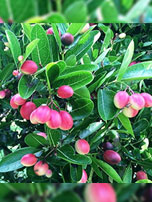Karamardha

Botanical Name : Carissa carandas Linn. Var congesta (Wt.) Bedd
Family : Apocynaceae.
Introduction :
In BAVAPRAKASHA two types of karamardha mentioned as karamardha dwaya. In kerala C. spinarum considered as the second. The Ayurvedic Pharmacopoeia of India indicated the stem bark in obstinate skin diseases, and the root in urinary disorders.
Names in different Indian languages :
English : Christ’s Thorn, Bengal Currant, karaunda, jasmine flowered carrisa
Hindi : Karunta, karonti
Kannada : karikayi
Malayalam : Klavu, karanta, perumklavu
Sanskrit : Karamardha, avighnah
Tamil : Kalakke, perumkla
Telugu : Peddakalavi, vaka
Unani : Karondaa.
Synonyms :
Karinkaara, Karamarda, Krishnapaakphal, Kshirphena, Sushena,
Varieties & adulterants – (CV – controversy, AD – adulterants) :
C. spinarum Linn.
Morphology :
Evergreen shrub with paired throns
Leaves – ovate, simple, opposite
Flower – white, corymbose
Fruit – globose- berry type
Seed – two in number, compressed
Distribution & Habitat :
All over India
Chemical constituents :
Vit C
Properties :
fruit
RASA- amlam
GUNA- guru
VIRYA-ushna
VIPAKA- katu
Karma : ruchyam, deepana, pachana, krimighna
Appetizer, antipyretic
Internal uses :
Digestive system : Constipating,
Skin : Scabies
Indication :
Diarrhea, worm, cabbies, pruritus
Used for acidity, flatulence, poor digestion, as a slimming diet. Juice of the fresh plant is used for infected wounds that refuse to heal.
Part used :
Root, fruit
Dosage :
Decoction – 60 -120 ml
Powder 2-4 gm
Therapeutic Uses :
Root—paste used for diabetic ulcer.